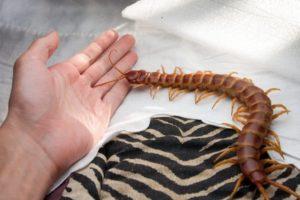Great centipede: meet the giant centipede and its relatives
There are many large insects and arthropods in the world that can instill fear and horror in humans. One of these is the scolopendra. In fact, all arthropods of this genus are large, predatory centipedes. But, among them there are species that stand out noticeably from the rest.
Content
Which centipede is the largest
The absolute record holder among representatives of the scolopendr genus is giant centipede. The average body length of this centipede is about 25 cm. Some individuals can even grow up to 30-35 cm.
Thanks to such an impressive size, the giant centipede can even hunt:
- small rodents;
- snakes and snakes;
- lizards;
- frogs.
The structure of her body is no different from the bodies of other centipedes. The body color of the arthropod is dominated by brown and reddish shades, and the limbs of the giant centipede are predominantly bright yellow in color.
Where does the giant centipede live?
Like most other arthropods, the giant centipede lives in countries with a hot climate. The habitat of this centipede is quite limited. You can meet her only in the northern and western parts of South America, as well as on the islands of Trinidad and Jamaica.
The conditions formed in the thick of humid, tropical forests are the most favorable for these large centipedes to live.
What is dangerous giant centipede for humans
The venom that the giant scolopendra releases during a bite is quite toxic and, until recently, was even considered deadly to humans. But, based on recent studies, scientists have nevertheless confirmed that for an adult, healthy person, a centipede bite is not fatal.
A dangerous toxin can kill most small animals, which later become food for centipedes. For a person, the bite in most cases causes the following symptoms:
- swelling;
- redness;
- itching;
- fever;
- dizziness;
- temperature increase;
- general malaise.
Other large species of centipedes
In addition to the giant centipede, there are several other large species in the genus of these arthropods. The following types of centipedes should be considered the largest:
- the California centipede, found in the Southwestern United States and northern Mexico;
- Vietnamese, or red skolopendra, which can be found in South and Central America, Australia, East Asia, as well as on the islands of the Indian Ocean and Japan;
- Scolopendra cataracta living in Southeast Asia, which is currently considered the only waterfowl species of centipede;
- Scolopendraalternans - a resident of Central America, the Hawaiian and Virgin Islands, as well as the island of Jamaica;
- Scolopendragalapagoensis, living in Ecuador, Northern Peru, on the western slopes of the Andes, as well as on the Hawaiian Islands and Chatham Island;
- the Amazonian giant centipede, which lives in South America mainly in the forests of the Amazon;
- Indian tiger centipede, which is a resident of the island of Sumatra, the Nykabor Islands, as well as the Indian Peninsula;
- the Arizona or Texas tiger centipede, which can be found in Mexico, as well as the US states of Texas, California, Nevada and, respectively, Arizona.
Conclusion
At first glance, it may seem that the inhabitants of a temperate climate have absolutely nothing to fear, because all the largest and most dangerous species of arthropods, insects and arachnids are found exclusively in hot countries, but this is not always the case.
There are many species that are not at all opposed to conquering new territories with a cooler climate. At the same time, in the cold season, they most often find shelter in warm human houses. Therefore, you should always carefully look under your feet.
